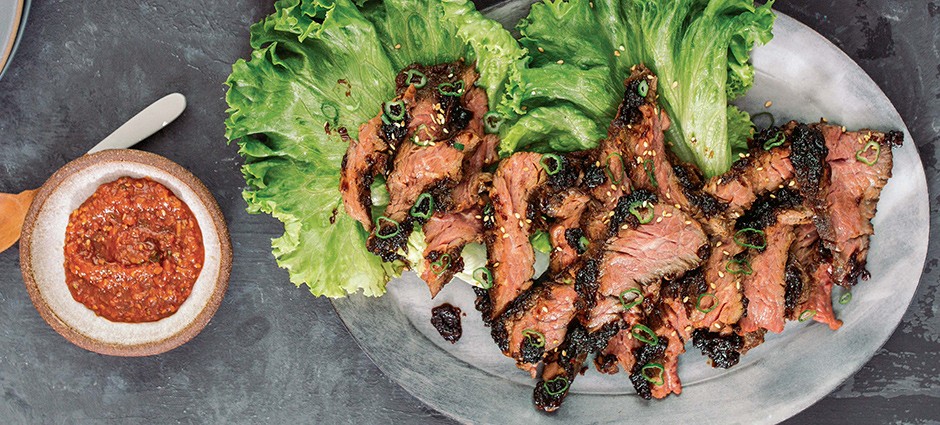Shop Ingredients
How this worksServings: 4
Ingredients
Steak
- 4 1 - 1 1/2" Steaks made with boneless cut of your choice (NY strip, ribeye, skirt, filet mignon)
- 1 tbsp soy sauce
Marinade
- 1 ⁄2 cup pear nectar apple juice, or lemon-lime soda, or 1⁄4 cup applesauce
- 1 ⁄4 cup soy sauce
- 2 tablespoons honey or light brown sugar
- 4 cloves garlic finely minced or grated
- 1 1 ⁄2 teaspoons peeled and finely minced or grated fresh ginger
- 3 or 4 green onions white and light green parts finely chopped, dark green parts thinly sliced and reserved for garnish
- 1 tablespoon toasted sesame oil
- 1 teaspoon freshly ground black pepper
- 1 teaspoon toasted sesame seeds for garnish
- 1 large head green leaf lettuce broken apart into leaves, washed and dried (about 12 leaves)
- 12 shiso or perilla leaves available at most Asian markets; optional
- 1 cup cooked rice preferably short grain; optional
- 1 ⁄2 cup ssamjang store-bought (optional)
Instructions
- Preheat the water bath to 55°C (131°F).
- Season the steaks with salt and soy sauce and place in a 1-gallon
freezer-safe ziplock bag or a vacuum seal bag. Arrange the pieces in a single
layer with as little overlap as possible to ensure even cooking. Seal the bag
using either the water displacement method or a vacuum sealer. - When the water reaches the target temperature, lower the bagged steak in the water
bath (making sure the bag is fully submerged) and cook for 1 hour (or up to 5
hours). - Remove the bag from the water bath. Let it rest in the bag at room temperature for
at least 10 minutes or up to 1 hour before proceeding. - Remove the cooked steak from the bag, reserving any liquid in the bag. Thoroughly pat the steak dry with paper towels. Set aside.
- Make the Marinade: In a small pot, combine the pear nectar, soy sauce, honey, garlic, ginger, green onions (white and light green parts only), sesame oil, and black pepper, along with the cooking liquid from the beef. Bring to a boil over medium heat and cook until the mixture is reduced by half and coats the back of a spoon, 3 to 5 minutes. Remove from the heat.
- Preheat a grill pan or skillet over medium-high heat. Brush the steak generously on both sides with the marinade. Lightly oil the grill. Working in batches if necessary, sear the steaks until caramelized and crisp on the edges, flipping every 1 minute, for a total of 3 to 4 minutes. Transfer the cooked steaks to a cutting board and brush or drizzle on any remaining glaze. Let the steaks rest for about 5 minutes before slicing them crosswise, against the grain. Transfer meat to a platter and sprinkle with the sesame seeds and reserved green onions.
- Arrange the lettuce and shiso leaves on a platter, along with bowls of the cooked rice and ssamjang. Serve family style, allowing people to assemble the wraps themselves, or do it for them: smear a small amount of ssamjang on each lettuce leaf, followed by a shiso leaf, a small amount of rice, and a few slices of steak. In either case, eaters will wrap the lettuce leaf around the fillings, creating a bundle—in Korea, it’s customary to eat the wrap in one big bite, but no one won’t think less of you if you take two or three.
Notes
If you’ve ever wanted to capture the tantalizing flavor of Korean barbecue in your own home, look no further. The inspiration for this dish, bulgogi, typically calls for tougher cuts of meat, thinly sliced and marinated before being cooked through to achieve tenderness. With gently cooked sous vide steak, tenderness is guaranteed. Ssamjang is a salty, rich condiment that’s essential for traditional Korean barbecue. Because the recipe makes a generous amount of glaze, the ssamjang optional, but it is readily available in Asian markets and online (as are perilla and shiso leaves).
Reprinted with permission from Sous Vide Made Simple, Ten Speed Press.
Tried this recipe?Mention @WPRecipeMaker or tag #wprecipemaker!
Rate This Recipe
Share this Post
DID YOU MAKE THIS RECIPE?
Leave a comment below and share a picture on Instagram with the hashtag #livenaturallymagazine

